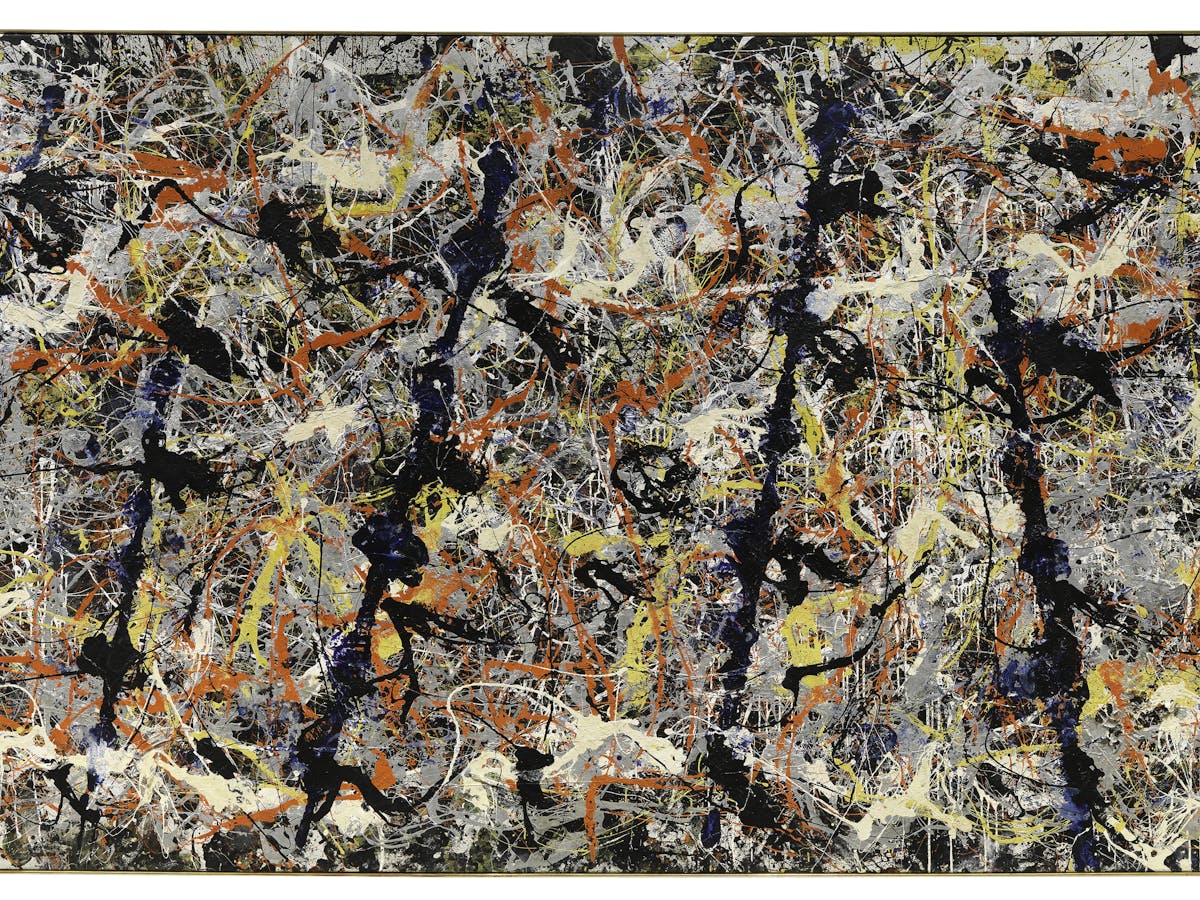Works of Art That Are Controversial as to if Its Art
niood lists the x Nearly Controversial Artworks That Inverse Art History:
1. Damien Hirst, For the Love of God, 2007
For the Love of God2007 is a life-size platinum bandage of an eighteenth century human being skull, covered by 8,601 flawless diamonds, inset with the original skull's teeth. At the front of the cranium is a 52.four carat pink diamond. Since it was starting time exhibited in 2007,For the Love of God has become one of the most widely recognised works of contemporary art. It represents the artist's continued involvement in mortality and notions of value.
This work of fine art was very controversial and generated many polemics, because of its huge cost and utilize of a human body office.

2. Pablo Picasso, Guernica, 1937
Picasso paintedGuernica at his home in Paris in response to the 26 April 1937, bombing of Guernica, a Basque Countrytown in northern Spain which was bombed by Nazi Federal republic of germany and Fascist Italy at the asking of the Spanish Nationalists. Upon completion,Guernica was exhibited at the Castilian brandish at the 1937 Paris International Exposition, and then at other venues around the world. The touring exhibition was used to raise funds for Spanish war relief. The painting soon became famous and widely acclaimed, and it helped bring worldwide attention to the Castilian Ceremonious War.
As early as 1968, Franco had expressed an interest in havingGuernica come to Spain. Withal, Picasso refused to let this until the Spanish people once more enjoyed a republic. He later added other conditions, such as the restoration of "public liberties and democratic institutions".
3. Marcel Duchamp – Fountain, 1917
When explaining the purpose of his Readymade sculpture, Duchamp stated they are "everyday objects raised to the dignity of a work of art past the artist'south human action of choice." In Duchamp'southward presentation, the urinal'southward orientation was altered from its usual positioning. The work is regarded by art historians and theorists of the avant-garde as a major landmark in 20th-century art.
To understand how Duchamp managed to outmanoeuvre the art world, ane needs to render to the moment that the scurrilous sculpture arrived for consideration at the recently formed Guild of Independent Artists in New York in spring 1917, in advance of an exhibition due to open on ten April. As a founding member of the association, Duchamp had helped devise and articulate the organisation'due south avant-garde ideology, including its commitment never to reject a work submitted by one of its members. To exam the sincerity and sturdiness of those principles, Duchamp entered the urinal under an causeless artistic identity – 'R Mutt' – knowing full well that the provocative slice would leave his beau players in the society scrambling for their adjacent motion.
Duchamp then watched with thwarting, if not surprise, when the question of whether to exhibit the piece was put to a vote, in hypocritical violation, he believed, of the society's widely-publicised open-mindedness. When Fountain was rejected by boyfriend members on grounds of aesthetic crudity, Duchamp found his conscience all of a sudden cornered. Left with no other possible move, he resigned.

four. Andy Warhol, Campbell's Soup Cans, 1962
When first exhibited, the use of printing techniques by the artist, his choice of mode and the commercial subject of the artwork placed it in the center of discussions regarding ethics and its validity as a piece of work of art, as his representation of mundane commercial products was a straight affront to abstract expressionism. These controversies helped promote Andy Warhol, thus transforming him into the well-nigh well-known pop creative person worldwide.

5. Andres Serrano, Piss Christ, 1987
Immersion (Piss Christ) is a 1987 photograph by the American artist and lensman Andres Serrano. It depicts a minor plastic crucifix submerged in a small glass tank of the creative person's urine.
The piece of work generated a big corporeality of controversy based on assertions that information technology was blasphemous. Serrano himself said of the controversy: "I had no ideaPiss Christ would get the attention it did, since I meant neither irreverence nor offense by information technology. I've been a Cosmic all my life, so I am a follower of Christ."

6. Guerilla Girls, Practice Women have to exist naked to become into the Met. Museum?, 1989
Since their inception in 1984 the Guerrilla Girls have been working to betrayal sexual and racial discrimination in the fine art globe, particularly in New York, and in the wider cultural arena. The group'southward members protect their identities past wearing gorilla masks in public and by bold pseudonyms taken from such deceased famous female person figures as the writer Gertrude Stein (1874-1946) and the artist Frida Kahlo (1907-54).
Dubbing themselves the 'censor of the fine art world', in 1985 the Guerrilla Girls began a poster entrada that targeted museums, dealers, curators, critics and artists who they felt were actively responsible for, or complicit in, the exclusion of women and non-white artists from mainstream exhibitions and publications.

7. Ai Weiwei, Dropping a Han Dynasty Urn, 1995
Artist, thinker, and activist Ai Weiwei was born in Beijing in 1957 and grew up in hard circumstances. His father, the poet Ai Qing, was persecuted by the Chinese Communist regime and exiled to a far western province. He was afterward hailed every bit a groovy national poet after the expiry of Mao Zedong in 1976. In 1981 Ai moved to New York, where he studied visual art and began working equally an artist. He also developed a deep appreciation of Marcel Duchamp's "readymades"—found objects of everyday use elevated to the status of art—and their implied critique of cultural value systems. In 1993, upon learning that his father was ill, he returned to China.
One of Ai's most famous pieces,Dropping a Han Dynasty Urn(1995), incorporates what Ai has chosen a "cultural readymade." The work captures Ai as he drops a 2,000-twelvemonth-old ceremonial urn, allowing it to smash to the floor at his feet. Not just did this artifact have considerable value, information technology also had symbolic and cultural worth. The Han dynasty (206 BCE–220 CE) is considered a defining menses in the history of Chinese civilization, and to deliberately break an iconic form from that era is equivalent to tossing away an entire inheritance of cultural pregnant about China.[ii] With this work, Ai began his ongoing use of antiquarian readymade objects, demonstrating his questioning attitude toward how and past whom cultural values are created.
Some were outraged by this work, calling it an human action of desecration. Ai countered by saying, "Chairman Mao used to tell us that we tin can only build a new globe if we destroy the old i." This statement refers to the widespread devastation of antiquities duringChina'south Cultural Revolution(1966–76) and the teaching that in social club to build a new society one must destroy thesi jiu(Four Olds): old customs, habits, culture, and ideas. By dropping the urn, Ai lets get of the social and cultural structures that impart value.

eight.Tracy Emin, My Bed, 1998
My Bed is a work by the English creative person Tracey Emin.
The idea forMy Bed was inspired by a sexual however depressive phase in the artist's life when she had remained in bed for four days without eating or drinking anything but booze. When she looked at the vile, repulsive mess that had accumulated in her room, she suddenly realised what she had created. Emin ardently defendedMy Bed against critics who treated it equally a farce and claimed that anyone could exhibit an unmade bed. To these claims the creative person retorted, "Well, they didn't, did they? No i had ever washed that before."

9.Jackson Pollock, Blue Poles or Number xi, 1952
Blue Poles, also known every bit Number 11, 1952 is an abstract expressionist painting by American artist Jackson Pollock. It was purchased amid controversy by the National Gallery of Australia in 1973 and today remains one of the gallery's major paintings.
The conquering ofBluish Poles, however, sparked a major controversy in Commonwealth of australia every bit people protested against the high cost paid for it – in fact, it was the highest price every paid for an American painting at that time. Taxpayers complained it was a waste of their money, and with few exceptions, the responses towards the painting, the National Gallery and the government were negative. Headlines likeA Pollock Sold for $2-Million, Record for American PaintingandWould you pay $ane.3m. for this? dominated newspapers and magazines.

10.Édouard Manet, Le Déjeuner sur l'Herbe, 1863
This amazing composition introduced an entirely new painterly arroyo, since it encompassed the genres of portraiture, landscape and however life within a single painting. Namely, information technology features a female nude on a picnic with two fully dressed men in a rural setting and a bather in the background. Manet produced this controversial work in-between 1862 and 1863 and was rejected by the notorious Paris Salon jury, and so the artist displayed it at Salon des Refusés instead.
The painting acquired quite a shock after it was displayed for the first time and was considered indecent and vulgar, although Manet's gimmicky and established writer and critic Émile Zola defended the work.

Source: https://niood.com/the-10-most-controversial-artworks-that-changed-art-history/
0 Response to "Works of Art That Are Controversial as to if Its Art"
Post a Comment